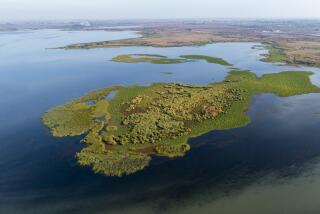Water Firm Seeks Rate Hike, Blames Pollution in Wells
- Share via
The water company that serves Duarte and Bradbury is seeking to increase rates by 74% over three years, in part to end its dependence on water wells that the company says are in danger of becoming contaminated.
But the staff of the state Public Utilities Commission has opposed plans by California-American Water Co. to use some of the $3.1-million rate hike to build a filtration plant that would draw water out of the San Gabriel River.
The company says ground water in the San Gabriel Valley is so badly polluted--and in such danger of further contamination--that it is wiser for the company to build a $2.5-million filtration plant to treat river water than to rely on existing wells. According to state health officials, compounds used in industrial solvents have contaminated 60 wells in the San Gabriel Valley, including one that had been used by the water company.
Councils Endorse Plant
The PUC, which must act on the rate request, will hold a hearing on the issue in San Francisco on Oct. 15.
The Duarte and Bradbury city councils have endorsed the plant’s construction but not the proposed rate increase.
Currently in Duarte and Bradbury, the average residential customer uses 1,857 cubic feet of water a month and pays $17.39. The company is seeking rate increases that would raise the monthly bill of such a customer to $23.18 in 1986, $26.61 in 1987 and $30.32 in 1988.
The water company, based in San Diego, also serves San Marino, where company officials also want to raise the rates.
In San Marino, the average residential customer uses 2,385 cubic feet of water a month and pays $17.45. The San Marino rate request, which also will be heard by the Public Utilities Commission on Oct. 15, would raise such an average monthly bill to $19.39 in 1986, $20.17 in 1987 and $20.78 in 1988.
Salaries, Other Expenses
The rate hike is needed in San Marino to cover increases in salaries and other operating expenses, the company says.
The gap between what San Marino and Duarte and Bradbury residents pay for comparable amounts of water would widen greatly in three years. By 1988, for example, under the rate proposals, Duarte residents would pay nearly $32 a month for 2,000 cubic feet of water, which would cost about $18 in San Marino.
Andrew Krueger, operations manager for the company’s Los Angeles region, said it is not fair to compare rates in different cities because of the varying costs of obtaining water and other factors.
In its rate application, California-American Water Co. notes that all wells serving the San Marino area are producing high-quality water requiring no treatment beyond chlorination.
But the proposed increase for Duarte and Bradbury includes a filtration plant to overcome the contamination risk to water wells.
Engineer Endorses Plant
Duarte City Engineer Dwight French said he agrees with the water company that it needs an alternative to ground water.
“The contamination level in the ground water is not going to subside,” he said.
But the PUC staff in its written analysis of the rate request says “there is no threat to the district’s operating well-water supply.” The staff reached that conclusion because the six wells that pump water for the company’s 6,500 customers in Duarte and Bradbury are free of contamination.
Krueger said use of two other wells has been discontinued because of contamination.
One was closed on advice of the state health department because of high levels of trichloroethylene (TCE), an industrial solvent. TCE is one of several volatile organic compounds that have seeped into wells in the San Gabriel Valley, forcing water companies to close the wells or treat the water.
Potential Health Risk
The contaminants are in tiny amounts--measured in parts per billion--but health officials say the levels are high enough to present a health risk because the compounds have caused cancer in laboratory animals.
Krueger said a second well was shut down after being contaminated with methane and carbon dioxide. Neither contaminant posed a health risk, he said, but they gave the water a bad odor and could cause water pipes to rust.
The PUC staff has suggested that the company replace the filtration plant proposal with construction of an aeration tower that would put the TCE-contaminated well back in service. The aeration tower, which would cost about $145,000, would remove TCE from the water and release it into the air.
The city of Arcadia water district and one in Baldwin Park have built aeration towers with approval of the South Coast Air Quality Management District, but Krueger said there is no assurance that his company could get the necessary permits now, given the potential impact on air quality. And, in any event, he said, the well with TCE is contaminated with nitrates, which cannot be removed by aeration.
Expensive Alternative
The only way to make high-nitrate water usable, he said, is to blend it with purer water from other wells, which would cost $450,000 in lines and equipment.
Krueger said the company fears that its six remaining wells could be affected by the spread of a plume of contaminated ground water that stretches under Irwindale, Baldwin Park and El Monte.
He said river water, flowing out of San Gabriel Canyon, is free of the industrial solvents that have seeped into ground water. The proposed plant on Fish Canyon Road in the northeast section of Duarte would be able to treat and deliver 6 million gallons a day. The plant could supply most of Duarte and Bradbury, except on high-demand days when the output would be supplemented by wells. The plant could be in operation by the summer of 1987.
One of the major reasons for building the plant is “customer peace of mind,” Krueger said. Every time a well is closed in the San Gabriel Valley, he said, customers flood the company with calls demanding assurances that their drinking water is safe.
Cheaper Than Pumping
Duarte City Manager Kenneth Caresio said another advantage of the filtration plant is that it is cheaper to draw water off the river and treat it in the plant than to pump water out of wells. Besides, he said, it simply makes no sense to rely on wells that may become contaminated when high-quality river water is available.
Caresio said the city has offered to help the company finance the plant through the sale of tax-exempt bonds, reducing the financing charges by half. Krueger said the company is studying the proposal.
Money raised from the rate hike would also be used for company salary increases, equipment needs and increased electrical power costs.
Several residents spoke against the rate proposal at a hearing in Duarte last week.
Rates Compared
Palmer G. Campen, retired school district superintendent, said he surveyed seven neighboring cities and found water rates much higher in Duarte. Even in San Marino, which is also served by California-American Water Co., rates are 14% lower, he said.
Campen said he does not have the technical expertise to determine whether the filtration plant is warranted but thinks many of the projected costs cited by the company in its rate application are out of line.
Other speakers complained that water rates are already too high.
More to Read
Sign up for Essential California
The most important California stories and recommendations in your inbox every morning.
You may occasionally receive promotional content from the Los Angeles Times.










